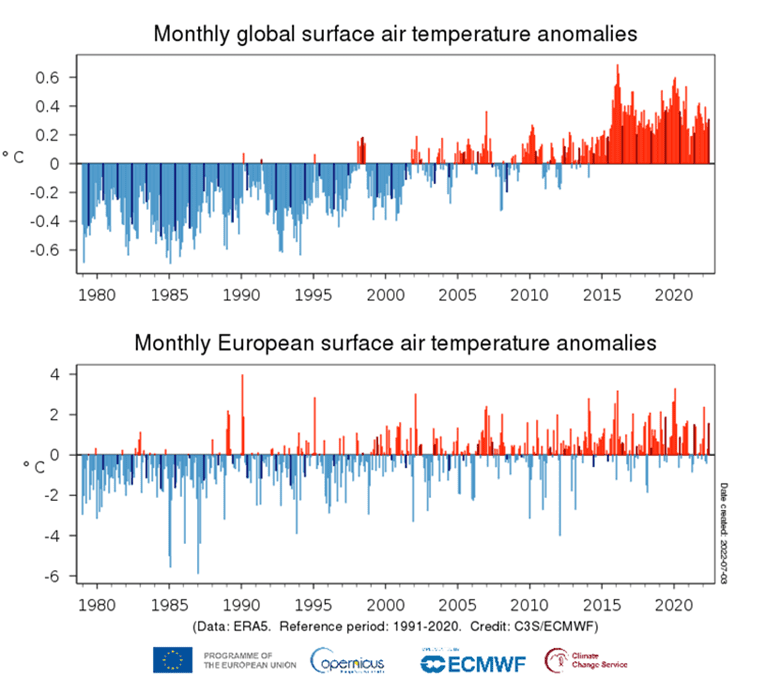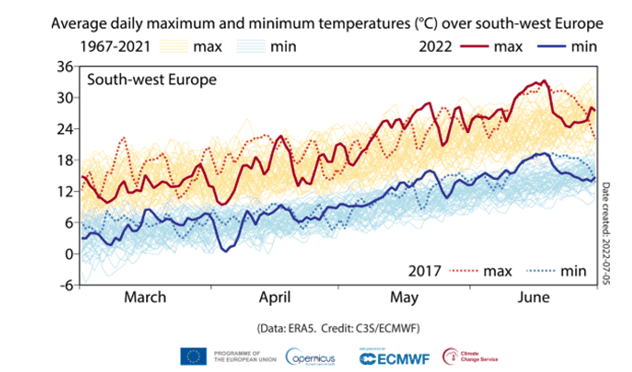Anomaly in surface air temperature for the month of June 2022 compared to the June average for the period 1991-2020. Data source: ERA5. Credit: Copernicus Climate Change Service/ECMWF.
Copernicus Climate Change Service (C3S)implemented by the European Center for Medium-Range Weather Forecasts on behalf of the European Commission, routinely publishes monthly climate bulletins that report on changes observed in the global report. surface air temperatureAnd the sea ice And the Hydrological variables. All reported results are based on computer-generated analyzes using billions of measurements from satellites, ships, aircraft and weather stations around the world.
Temperature Peaks – June 2022
- The global average temperature for June 2022 was about 0.31°C higher than the 1991-2020 average, making it the third hottest June month on record.
- Europe as a whole experienced the second warmest month on record, with 1.6°C above average
- Extreme temperatures have occurred in Spain, France, and parts of Italy. Temperatures were also above average in China, Japan and the United States
- Colder-than-average temperatures were measured over Greenland and most of South America
Monthly global mean and European average deviations in surface temperatures with respect to 1991-2020, from January 1979 to June 2022. The darker colored bars indicate the June values. Data source: ERA5. Source: Copernicus Climate Change Service / ECMWF.
The Copernicus Climate Change Service (C3S) reports on regions that have experienced long periods of exceptionally high temperatures. These include areas in Spain, Italy and France, as well as parts of northern China and Japan where heat has broken local records. The June atmosphere has warmed since the early 1970s at the Earth’s surface at twice the speed over extratropical land areas in the Northern Hemisphere than it has worldwide.
Although heat waves in parts of Europe and Asia are exceptional, the events are not unexpected. In line with the evidence described in the post IPCC assessment reportThere is an increase in the frequency and intensity of heat waves and the increase can be attributed, according to the Intergovernmental Panel on Climate Change, to human-induced climate change. It is expected to continue in the future when the global climate warms. Heat waves, defined as a prolonged period of high temperatures, can pose health risks such as heat exhaustion, severe dehydration, and increased risks for those with chronic diseases..
Average daily maximum and minute temperatures (°C) over southwestern Europe. Source: ERA5. Credit: ECMWF Copernicus Climate Change Service (C3S)
Extreme heat waves tend to occur in fairly large areas, often several countries at once, as a series of several warm periods. Southwest Europe experienced its first warm period in the latter part of May, and another period of exceptional temperatures culminated on June 17. This contrasts starkly with the region’s frigid temperatures during the early days of April 2022, and minimums later that month in Spain. Temperatures in June dropped rapidly after reaching their maximum and heat waves moved east and north.
Average daily maximum and minimum deviations of surface air temperatures for Southwest Europe For the months of May and June from 1967 to 2022 compared to 1991-2020. Data source: ERA5. Source: Copernicus Climate Change Service / ECMWF
“Heat waves similar to those observed this year are expected to increase more frequent and intense in the coming years, both in Europe and beyond,” says Carlo Bontempo, director of the Copernicus Climate Change Service. “It is especially important that reliable data be available to the public so that everyone can Follow trends and prepare for the future.”
Maps and specific temperature data values are from the ECMWF Copernicus Climate Change Services ERA5 dataset. Zone averages of temperatures over the European zone are only for countries with the following latitude/longitude limits: 25W-40E, 34N-72N.
The maps and data values for sea ice were taken from a set of information from ERA5, as well as from EUMETSAT OSI SAF Sea Ice Index v2.1 and Sea Ice Concentration CDR/ICDR v2 and Fast Track data provided as requested by OSI SAF.
C3S followed the recommendation of the World Meteorological Organization (WMO) to use the past 30 years to calculate climate averages and changed to the 1991-2020 reference period for C3S Climate Bulletins covering January 2021 and beyond. Figures and graphics for both the new and previous periods (1981-2010) are provided for transparency.
Videos accompanying the maps are available over here
more information About May’s climate fluctuations and climate updates from previous months as well as high-resolution graphics can be downloaded here:
https://climate.copernicus.eu/monthly-climate-bulletins
More information about C3S’s analysis of the latest heat waves including definitions of geographic areas and datasets used can be found here:
https://climate.copernicus.eu/early-2022-heatwaves-grip-parts-europe-asia-and-north-america/?PR
More information about how C3S data is collected:
https://climate.copernicus.eu/climate-bulletin-about-data-and-analysis
More information about changing the reference period:
https://climate.copernicus.eu/new-decade-reference-period-change-climate-data
Answers to frequently asked questions about temperature monitoring: https://climate.copernicus.eu/temperature-qas
About Copernicus and ECMWF
Copernicus is part of the European Union’s Space Programme, funded by the European Union, the flagship Earth observation programme. The company operates through six thematic services: Atmosphere, Marine, Land, Climate Change, Security and Emergencies. It provides freely available operational data and services that provide users with reliable and up-to-date information about our planet and its environment. The program is coordinated and managed by the European Commission and implemented in partnership with Member States, the European Space Agency (ESA), the European Organization for the Exploitation of Meteorological Satellites (EUMTSAT), the European Center for Medium Distance Forecasting (ECMWF), European Union agencies, Mercator Océan and more.
ECMWF operates two services of the European Union’s Copernicus Earth Observation Program: the Copernicus Atmospheric Monitoring Service (CAMS) and the Copernicus Climate Change Service (C3S). They also contribute to the Copernican Emergency Management Service (CEMS), which is implemented by the European Union Joint Research Council (JRC). The European Center for Medium Range Weather Forecasts (ECMWF) is an independent intergovernmental organization supported by 35 countries. It is a 24/7 operational research and service institute that produces and publishes digital weather forecasts to its member states. These data are fully available to the national meteorological services of the member states. The supercomputer facility (and associated data archives) at the ECMWF is one of the largest of its kind in Europe and member states can use 25% of its capacity for their own purposes.
ECMWF has increased the number of places in which it does business. In addition to the main office in the UK and the computing center in Italy, new offices focusing on activities implemented in partnership with the European Union, such as Copernicus, will be located in Bonn, Germany starting in the summer of 2021.
Copernicus Atmosphere Monitoring Service: http://atmosphere.copernicus.eu/
Copernicus Climate Change Service: https://climate.copernicus.eu/
More information about Copernicus: www.copernicus.eu
ECMWF Web: https://www.ecmwf.int/
Twitter:
Tweet embed
Tweet embed
Tweet embed
Media connection
Nuria Lopez
Communication | Copernicus contracts and the press
General manager’s office
European Center for Medium-Range Weather Forecasts
Reading, UK | Bologna, Italy
Email: [email protected]
Phone: +44 (0) 118949 9778
Mobile: +44 (0) 7392277523
Twitter: Tweet embed
Bjorn Mogensen
Oxenstierna Communication
+46 708-184298
[email protected]
Tags:

“Extreme tv maven. Beer fanatic. Friendly bacon fan. Communicator. Wannabe travel expert.”










More Stories
Brexit brings economic uncertainty – Finland worst hit in the long run – Hufvudstadsbladet
Britain wants closer ties with the European Union.
Britain may already be out of recession